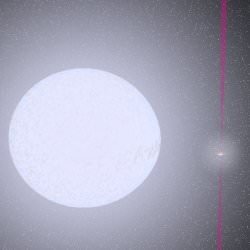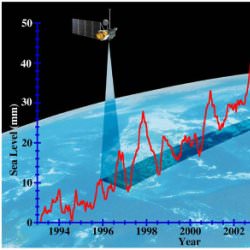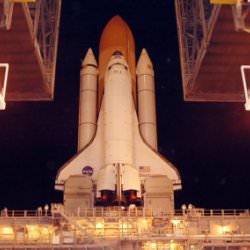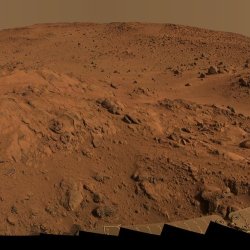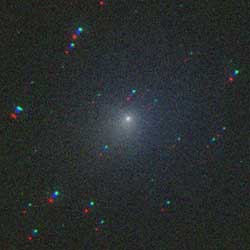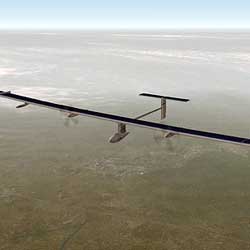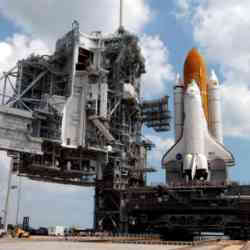
Space shuttle Discovery on the launch pad. Image credit: NASA. Click to enlarge.
A new study, funded in part by the Naval Research Laboratory and the National Aeronautics and Space Administration (NASA) reports that exhaust from the space shuttle can create high-altitude clouds over Antarctica mere days following launch, providing valuable insight to global transport processes in the lower thermosphere[mhs1]. The same study also finds that the shuttle’s main engine exhaust plume carries small quantities of iron that can be observed from the ground, half a world away.
The international team of authors of the study, to appear in the July 6 issue of Geophysical Research Letters, used the STS-107 Shuttle mission as a case study to show that exhaust released in the lower thermosphere, near 110 kilometers altitude, can form Antarctic polar mesospheric clouds (PMCs). The thermosphere is the highest layer in our atmosphere, with the mesosphere (between 50-90 kilometers above the Earth), stratosphere, and troposphere below.
New observations presented by the research team from the Global Ultraviolet Imager (GUVI) on NASA’s Thermosphere, Ionosphere, Mesosphere, Energetics and Dynamics (TIMED) satellite reveal transport of the STS-107 exhaust into the southern hemisphere just two days after the January 2003 launch. Water from the exhaust ultimately led to a significant burst of PMCs during the 2002-2003 southern polar summer, observed by the Solar Backscatter Ultraviolet (SBUV) satellite experiment. The inter-hemispheric transport followed by Antarctic PMC formation were unexpected.
PMCs, also known as noctilucent clouds, appear near 83 kilometers altitude and are made up of water ice particles created through microphysical processes of nucleation, condensation, and sedimentation. They typically appear in the frigid polar summer mesosphere where temperatures plummet below 130? Kelvin (-220? F). Little is known about the specific processes that lead to PMC formation.
According to the study’s lead author, Dr. Michael Stevens, a research physicist at the E.O. Hulburt Center for Space Research at the Naval Research Laboratory, the research produced multiple groundbreaking science results.
“This research is exciting in that it extends a new explanation for the formation of these clouds by demonstrating the global effect of a Shuttle exhaust plume in a region of the atmosphere that has traditionally not been well understood,” said Stevens.
Some believe that the impact of anthropogenic change in the lower atmosphere is reflected in these upper atmospheric clouds. Although historically PMCs have only been seen in the polar region, in recent years PMCs have been spotted at lower latitudes as far south as [mhs2]Colorado and Utah, renewing interest and sparking debate on the implications. However, the findings of this work, “call into question the interpretation of the impact of late 20th century PMC trends solely in terms of global climate change,” Stevens said. The team concludes that the water from a space shuttle’s exhaust plume can contribute a remarkable 10-20 percent to PMCs observed during one summer season in Antarctica.
A key piece of data that confirmed the plume’s arrival in Antarctica was the ground-based observation of iron atoms near 110 km. The presence of iron at this altitude originally perplexed scientists because there is no known natural source there. The data imply that iron ablated, or vaporized, by the main engines of the Shuttle was transported along with the water plume, arriving in Antarctica three to four days after the January 2003 launch. Both the water plume and the presence of iron demonstrate that the mean southward wind inferred from the team’s data is much faster than gleaned from global circulation models or wind climatologies.
“This tells us something new and exciting about transport in this region of the atmosphere,” said Stevens. “It can be so fast that a shuttle plume can form ice over Antarctica before other loss processes can really take effect. We must take great care in interpreting the long-term implications to observations and features of these clouds because of this contribution from the shuttle and the potential contribution from many other smaller launch vehicles.”
NRL and NASA funded the study, with contributions from the National Science Foundation, the British Antarctic Survey in Cambridge, United Kingdom, and the University of Illinois, Urbana-Champaign. Other researchers on the study include Robert Meier of George Mason University, Fairfax, Va.; Xinzhao Chu of the University of Illinois, Urbana-Champaign; Matthew DeLand of Science Systems & Applications, Inc., Lanham, Md.; and John Plane of the University of East Anglia, Norwich, United Kingdom.
Original Source: NRL News Release

